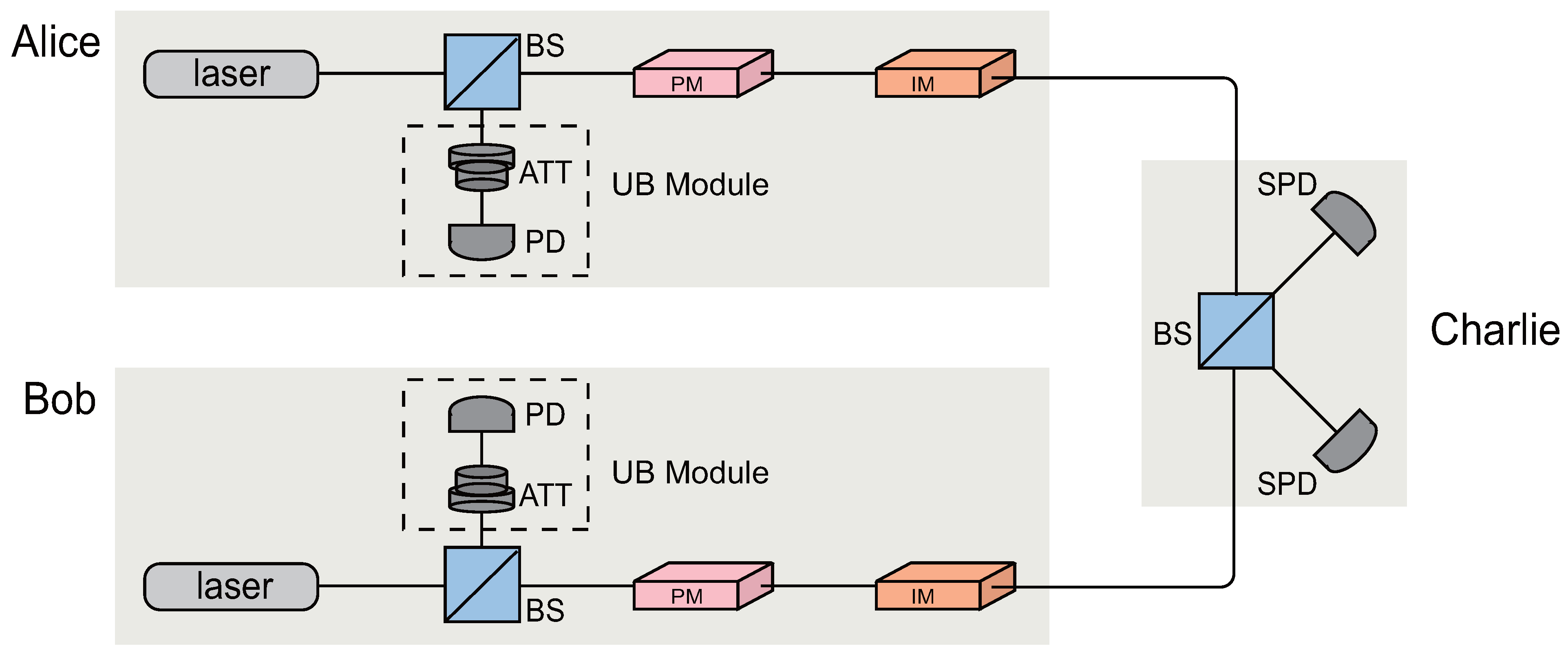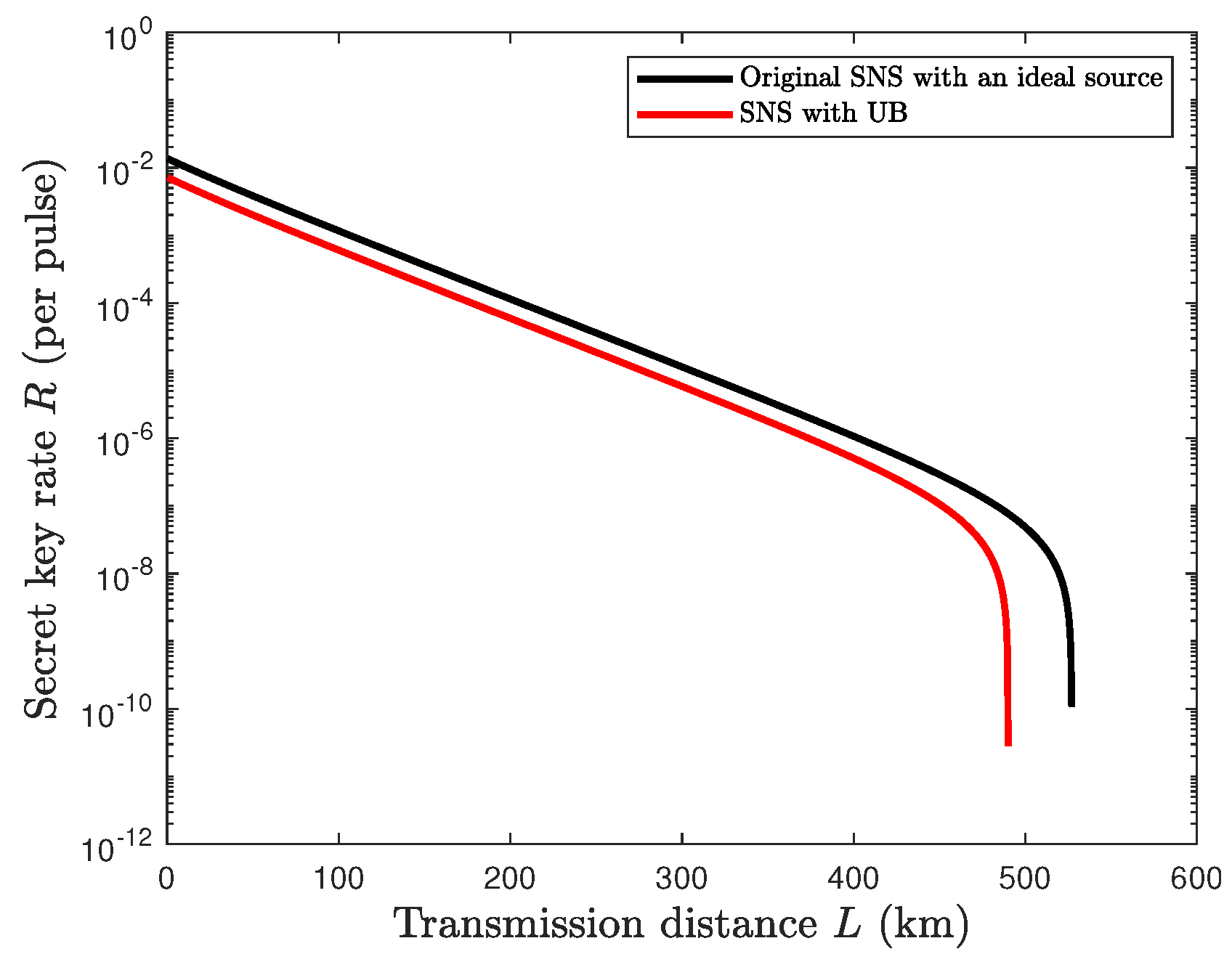An Effective Parameter Analysis for Sending-or-Not-Sending Quantum Key Distribution with Untrusted Light Sources
Abstract
1. Introduction
2. SNS Protocol with UB
2.1. Introduction of SNS Protocol
- At each time window i, Alice (Bob) determines whether it is a signal or decoy window. If it is a decoy window, Alice (Bob) prepares a coherent state and sends it to Charlie. If it is a signal window, Alice (Bob) prepares a coherent state with probability and sends it to Charlie. and represent the photon intensity of the decoy state and the signal state, represents the random phase, and represents the phase offset of the channel.
- Charlie receives the states sent by Alice and Bob and publishes all the measurement results for the effective events. Effective events are defined as follows: (1) When Alice and Bob simultaneously decide on the signal window, Alice (Bob) decides to send the signal, while Bob (Alice) decides not to send it, corresponding to Charlie announcing only detector clicks. (2) When Alice and Bob simultaneously decide on the decoy window, they prepare coherent states with the same intensity, and in this window, the random phases and satisfy [25]corresponding to Charlie announcing only detector clicks. The value of is determined by the size of the phase slice chosen by Alice and Bob, as described in Ref. [24].
- After Charlie publishes all the measurement results, Alice and Bob announce all the windows and the details of the decoy windows to classify the data accordingly and determine the parameters of the security key formula.
2.2. Security Analysis
2.3. Parameters Estimation with UB
3. Performance with Numerical Simulation
4. Conclusions
Author Contributions
Funding
Conflicts of Interest
Appendix A. The Bounds Estimation of
References
- Bennett, C.H.; Brassard, G. Quantum cryptography: Public key distribution and coin tossing. Theor. Comput. Sci. 2014, 560, 7–11. [Google Scholar] [CrossRef]
- Bennett, C.H.; Brassard, G.; Mermin, N.D. Quantum cryptography without Bell’s theorem. Phys. Rev. Lett. 1992, 68, 557. [Google Scholar] [CrossRef] [PubMed]
- Scarani, V.; Acin, A.; Ribordy, G.; Gisin, N. Quantum cryptography protocols robust against photon number splitting attacks for weak laser pulse implementations. Phys. Rev. Lett. 2004, 92, 057901. [Google Scholar] [CrossRef]
- Inoue, K.; Waks, E.; Yamamoto, Y. Differential phase shift quantum key distribution. Phys. Rev. Lett. 2002, 89, 037902. [Google Scholar] [CrossRef] [PubMed]
- Bruß, D. Optimal eavesdropping in quantum cryptography with six states. Phys. Rev. Lett. 1998, 81, 3018. [Google Scholar] [CrossRef]
- Bennett, C.H.; Bessette, F.; Brassard, G.; Salvail, L.; Smolin, J. Experimental quantum cryptography. J. Cryptol. 1992, 5, 3–28. [Google Scholar] [CrossRef]
- Bechmann-Pasquinucci, H.; Tittel, W. Quantum cryptography using larger alphabets. Phys. Rev. A 2000, 61, 062308. [Google Scholar] [CrossRef]
- Cerf, N.J.; Bourennane, M.; Karlsson, A.; Gisin, N. Security of quantum key distribution using d-level systems. Phys. Rev. Lett. 2002, 88, 127902. [Google Scholar] [CrossRef]
- Mower, J.; Zhang, Z.; Desjardins, P.; Lee, C.; Shapiro, J.H.; Englund, D. High-dimensional quantum key distribution using dispersive optics. Phys. Rev. A 2013, 87, 062322. [Google Scholar] [CrossRef]
- Liu, J.; Lin, Z.; Liu, D.; Feng, X.; Liu, F.; Cui, K.; Zhang, W. High-dimensional quantum key distribution using energy-time entanglement over 242 km partially deployed fiber. Quantum Sci. Technol. 2024, 9, 015003. [Google Scholar] [CrossRef]
- Zahidy, M.; Ribezzo, D.; De Lazzari, C.; Vagniluca, I.; Biagi, N.; Müller, R.; Bacco, D. Practical high-dimensional quantum key distribution protocol over deployed multicore fiber. Nat. Commun. 2024, 15, 1651. [Google Scholar] [CrossRef] [PubMed]
- Sekga, C.; Mafu, M.; Senekane, M. High-dimensional quantum key distribution implemented with biphotons. Sci. Rep. 2023, 13, 1229. [Google Scholar] [CrossRef]
- Ding, Y.; Bacco, D.; Dalgaard, K.; Cai, X.; Zhou, X.; Rottwitt, K.; Oxenløwe, L.K. High-dimensional quantum key distribution based on multicore fiber using silicon photonic integrated circuits. npj Quantum Inf. 2017, 3, 25. [Google Scholar] [CrossRef]
- Lütkenhaus, N. Security against individual attacks for realistic quantum key distribution. Phys. Rev. A 2000, 61, 052304. [Google Scholar] [CrossRef]
- Makarov, V.; Hjelme, D.R. Faked states attack on quantum cryptosystems. J. Mod. Opt. 2005, 52, 691–705. [Google Scholar] [CrossRef]
- Qi, B.; Fung, C.H.F.; Lo, H.K.; Ma, X. Time-shift attack in practical quantum cryptosystems. arXiv 2005, arXiv:quant-ph/0512080. [Google Scholar] [CrossRef]
- Wei, K.; Liu, H.; Ma, H.; Yang, X.; Zhang, Y.; Sun, Y.; Xiao, J.; Ji, Y. Feasible attack on detector-device-independent quantum key distribution. Sci. Rep. 2017, 7, 449. [Google Scholar] [CrossRef]
- Gottesman, D.; Lo, H.K.; Lütkenhaus, N.; Preskill, J. Security of quantum key distribution with imperfect devices. In Proceedings of the International Symposium on Information Theory (ISIT 2004), Chicago, IL, USA, 27 June–2 July 2004; Volume 136. [Google Scholar]
- Hwang, W.-Y. Quantum key distribution with high loss: Toward global secure communication. Phys. Rev. Lett. 2003, 91, 057901. [Google Scholar] [CrossRef]
- Xu, F.; Curty, M.; Qi, B.; Lo, H.-K. Practical aspects of measurement-device-independent quantum key distribution. New J. Phys. 2013, 15, 113007. [Google Scholar] [CrossRef]
- Zhou, Y.-H.; Yu, Z.-W.; Wang, X.-B. Tightened estimation can improve the key rate of measurement-device-independent quantum key distribution by more than 100%. Phys. Rev. A 2014, 89, 052325. [Google Scholar] [CrossRef]
- Zhou, Y.-H.; Yu, Z.-W.; Wang, X.-B. Making the decoy-state measurement-device-independent quantum key distribution practically useful. Phys. Rev. A 2016, 93, 042324. [Google Scholar] [CrossRef]
- Lo, H.K.; Curty, M.; Qi, B. Measurement-device-independent quantum key distribution. Phys. Rev. Lett. 2012, 108, 130503. [Google Scholar] [CrossRef]
- Lucamarini, M.; Yuan, Z.L.; Dynes, J.F.; Shields, A.J. Overcoming the rate–distance limit of quantum key distribution without quantum repeaters. Nature 2018, 557, 400–403. [Google Scholar] [CrossRef]
- Wang, X.B.; Yu, Z.W.; Hu, X.L. Twin-field quantum key distribution with large misalignment error. Phys. Rev. A 2018, 98, 062323. [Google Scholar] [CrossRef]
- Yu, Z.W.; Hu, X.L.; Jiang, C.; Xu, H.; Wang, X.B. Sending-or-not-sending twin-field quantum key distribution in practice. Sci. Rep. 2019, 9, 3080. [Google Scholar] [CrossRef]
- Hu, X.L.; Jiang, C.; Yu, Z.W.; Wang, X.B. Sending-or-not-sending twin-field protocol for quantum key distribution with asymmetric source parameters. Phys. Rev. A 2019, 100, 062337. [Google Scholar] [CrossRef]
- Jiang, C.; Yu, Z.W.; Hu, X.L.; Wang, X.B. Unconditional security of sending or not sending twin-field quantum key distribution with finite pulses. Phys. Rev. Appl. 2019, 12, 024061. [Google Scholar] [CrossRef]
- Peng, Q.; Chen, J.P.; Xing, T.; Wang, D.; Wang, Y.; Liu, Y.; Huang, A. Practical security of twin-field quantum key distribution with optical phase-locked loop under wavelength-switching attack. npj Quantum Inf. 2025, 11, 7. [Google Scholar] [CrossRef]
- Sun, M.S.; Zhang, C.H.; Ma, X.; Zhou, X.Y.; Wang, Q. Sending-or-not-sending twin-field quantum key distribution with measurement imperfections. IEEE Commun. Lett. 2022, 26, 2004–2008. [Google Scholar] [CrossRef]
- Chen, J.-P.; Zhang, C.; Liu, Y.; Jiang, C.; Zhang, W.; Hu, X.-L.; Guan, J.-Y.; Yu, Z.-W.; Xu, H.; Lin, J.; et al. Sending-or-Not-Sending with Independent Lasers: Secure Twin-Field Quantum Key Distribution over 509 km. Phys. Rev. Lett. 2020, 124, 070501. [Google Scholar] [CrossRef]
- Liu, H.; Jiang, C.; Zhu, H.T.; Zou, M.; Yu, Z.W.; Hu, X.L.; Xu, H.; Ma, S.; Han, Z.; Chen, J.-P.; et al. Field test of twin-field quantum key distribution through sending-or-not-sending over 428 km. Phys. Rev. Lett. 2021, 126, 250502. [Google Scholar] [CrossRef]
- Liu, Y.; Zhang, W.J.; Jiang, C.; Chen, J.P.; Zhang, C.; Pan, W.X.; Ma, D.; Dong, H.; Xiong, J.-M.; Zhang, C.-J.; et al. Experimental twin-field quantum key distribution over 1000 km fiber distance. Phys. Rev. Lett. 2023, 130, 210801. [Google Scholar] [CrossRef]
- Liu, Y.; Zhang, W.J.; Jiang, C.; Chen, J.P.; Ma, D.; Zhang, C.; Pan, J.W. 1002 km twin-field quantum key distribution with finite-key analysis. Quantum Front. 2023, 2, 16. [Google Scholar] [CrossRef]
- Shan, Y.G.; Zhou, Y.; Yin, Z.Q.; Wang, S.; Chen, W.; He, D.Y.; Han, Z.F. Sending-or-not-sending quantum key distribution with phase postselection. Phys. Rev. Appl. 2024, 22, 024056. [Google Scholar] [CrossRef]
- Qiao, Y.; Chen, Z.; Zhang, Y.; Xu, B.; Guo, H. Sending-or-not-sending twin-field quantum key distribution with light source monitoring. Entropy 2019, 22, 36. [Google Scholar] [CrossRef]
- Lu, Y.F.; Wang, Y.; Jiang, M.S.; Liu, F.; Zhang, X.X.; Bao, W.S. Finite-key analysis of sending-or-not-sending twin-field quantum key distribution with intensity fluctuations. Quantum Inf. Process. 2021, 20, 135. [Google Scholar] [CrossRef]
- Xue, K.; Zhao, S.; Mao, Q.; Xu, R. Plug-and-play sending-or-not-sending twin-field quantum key distribution. Quantum Inf. Process. 2021, 20, 320. [Google Scholar] [CrossRef]
- Xue, K.; Shen, Z.; Zhao, S.; Mao, Q. Sending-or-Not-Sending Twin-Field Quantum Key Distribution with a Passive Decoy-State Method. Entropy 2022, 24, 662. [Google Scholar] [CrossRef]
- Lu, Y.F.; Wang, Y.; Jiang, M.S.; Zhang, X.X.; Liu, F.; Li, H.W.; Zhou, C.; Tang, S.-B.; Wang, J.-Y.; Bao, W.-S. Sending or Not-Sending Twin-Field Quantum Key Distribution with Flawed and Leaky Sources. Entropy 2021, 23, 1103. [Google Scholar] [CrossRef]
- Xu, H.; Hu, X.L.; Feng, X.L.; Wang, X.B. Hybrid protocol for sending-or-not-sending twin-field quantum key distribution. Opt. Lett. 2020, 45, 4120–4123. [Google Scholar] [CrossRef]
- Hu, X.L.; Jiang, C.; Yu, Z.W.; Wang, X.B. Sending-or-not-sending twin-field quantum key distribution with imperfect vacuum sources. New J. Phys. 2022, 24, 063014. [Google Scholar] [CrossRef]
- Wen, K.; Fei, L.; Wan, Z.A.; Wu, X.Y.; Li, H.T.; Peng, H.; Li, Y.P. Intensity fluctuation analysis for sending or not sending twin field quantum key distribution. Proc. SPIE 2023, 12617, 1390–1397. [Google Scholar]
- Sun, M.S.; Wang, W.L.; Zhou, X.Y.; Zhang, C.H.; Wang, Q. Source monitoring twin-field quantum key distribution assisted with Hong-Ou-Mandel interference. Phys. Rev. Res. 2023, 5, 043179. [Google Scholar] [CrossRef]
- Zhao, Y.; Qi, B.; Lo, H.K. Quantum key distribution with an unknown and untrusted source. Phys. Rev. A 2008, 77, 052327. [Google Scholar] [CrossRef]
- Park, J.; Lee, J.; Heo, J. Improved statistical fluctuation analysis for twin-field quantum key distribution. Quantum Inf. Process. 2021, 20, 127. [Google Scholar] [CrossRef]



| f | ||||
|---|---|---|---|---|
| 0.2 dB/km | 0.8 | 1% | 1.1 |
Disclaimer/Publisher’s Note: The statements, opinions and data contained in all publications are solely those of the individual author(s) and contributor(s) and not of MDPI and/or the editor(s). MDPI and/or the editor(s) disclaim responsibility for any injury to people or property resulting from any ideas, methods, instructions or products referred to in the content. |
© 2025 by the authors. Licensee MDPI, Basel, Switzerland. This article is an open access article distributed under the terms and conditions of the Creative Commons Attribution (CC BY) license (https://creativecommons.org/licenses/by/4.0/).
Share and Cite
Huang, J.; Li, W.; Qiao, Y. An Effective Parameter Analysis for Sending-or-Not-Sending Quantum Key Distribution with Untrusted Light Sources. Entropy 2025, 27, 547. https://doi.org/10.3390/e27060547
Huang J, Li W, Qiao Y. An Effective Parameter Analysis for Sending-or-Not-Sending Quantum Key Distribution with Untrusted Light Sources. Entropy. 2025; 27(6):547. https://doi.org/10.3390/e27060547
Chicago/Turabian StyleHuang, Jiajian, Weigang Li, and Yucheng Qiao. 2025. "An Effective Parameter Analysis for Sending-or-Not-Sending Quantum Key Distribution with Untrusted Light Sources" Entropy 27, no. 6: 547. https://doi.org/10.3390/e27060547
APA StyleHuang, J., Li, W., & Qiao, Y. (2025). An Effective Parameter Analysis for Sending-or-Not-Sending Quantum Key Distribution with Untrusted Light Sources. Entropy, 27(6), 547. https://doi.org/10.3390/e27060547






